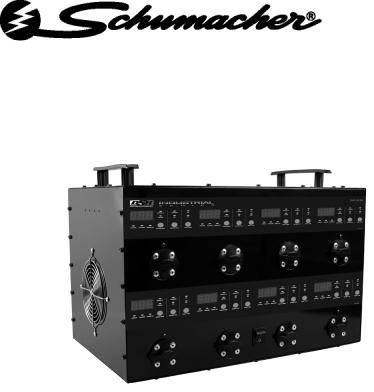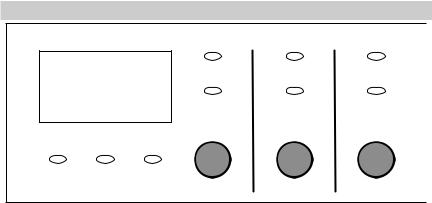Schumacher 00-99-000886-1208, INC-812A, 00-99-000886, 94080037 User Manual

Model INC-812
Automatic Battery Charger
Fully Automatic
Microprocessor Controlled
Battery Charging Station
READ ENTIRE MANUAL BEFORE
USING THIS PRODUCT
CAUTION:
Read all Safety Rules and Operating Instructions, and follow them with each use of this product.
00-99-000886/1208

TABLE OF Contents
section |
PAGE |
IMPORTANT SAFETY INSTRUCTIONS |
1 |
PERSONAL PRECAUTIONS |
2 |
PREPARING TO CHARGE |
2 |
CHARGER LOCATION |
3 |
DC CONNECTION PRECAUTIONS |
3 |
FOLLOW THESE STEPS WHEN BATTERY IS |
|
INSTALLED INVEHICLE. |
3 |
FOLLOW THESE STEPS WHEN BATTERY IS |
|
OUTSIDE VEHICLE. |
4 |
battery charging - ac connections |
4 |
Assembly instructions |
5 |
control panel |
6 |
operating instructions |
7 |
using the volt meter to test battery |
|
state of charge |
8 |
battery percent and charge time |
9 |
maintenance instructions |
10 |
storage instructions |
10 |
troubleshooting |
11 |
Limited warranty |
12 |

IMPORTANT: read and save this safety and instruction manual.
1.IMPORTANT SAFETY INSTRUCTIONS
1.1SAVE THESE INSTRUCTIONS – This manual contains important safety and operating instructions for battery charger Model INC-812A.
1.2WARNING: This product contains chemicals known to the State of California to cause cancer and birth defects or other reproductive harm. Wash hands after handling.
1.3Do not expose charger to rain or snow.
1.4Use of an attachment not recommended or sold by Schumacher® Electric
Corporation may result in a risk of fire, electric shock or injury to persons or damage to property.
1.5To reduce the risk of damage to electric plug or cord, pull by the plug rather than the cord when disconnecting the charger.
1.6An extension cord should not be used unless absolutely necessary. Use of an improper extension cord could result in a risk of fire and electric shock.
If an extension cord must be used, make sure:
•That the pins on the plug of the extension cord are the same number, size and shape as those of the plug on the charger.
•That the extension cord is properly wired and in good electrical condition and;
•That the wire size is large enough for the AC ampere rating of the charger as specified in section 8.
1.7Do not operate the charger with a damaged cord or plug; take it to a qualified serviceman. (Call customer service at: 800-621-5485).
1.8Do not operate the charger if it has received a sharp blow, been dropped or otherwise damaged in any way; take it to a qualified serviceman. (Call customer service at: 800-621-5485).
1.9Do not disassemble the charger; take it to a qualified serviceman when service or repair is required. Incorrect reassembly may result in a risk of electric shock or fire. (Call customer service at: 800-621-5485).
1.10To reduce the risk of electric shock, unplug the charger from the outlet before attempting any maintenance or cleaning. Turning off the controls will not reduce this risk.
WARNING – RISK OF EXPLOSIVE GASES.
WORKING IN THE VICINITY OF A LEAD-ACID BATTERY IS DANGEROUS. BATTERIES GENERATE EXPLOSIVE GASES DURING NORMAL BATTERY OPERATION. FOR THIS REASON, IT IS OF UTMOST IMPORTANCE THAT YOU FOLLOW THE INSTRUCTIONS EACH TIME YOU USE THE CHARGER.
•1 •

TO REDUCE THE RISK OF BATTERY EXPLOSION, FOLLOW THESE INSTRUCTIONS AND THOSE PUBLISHED BY THE BATTERY MANUFACTURER AND THE MANUFACTURER OF ANY EQUIPMENT YOU INTEND TO USE IN THE VICINITY OF THE BATTERY. REVIEW THE CAUTIONARY MARKINGS ON THESE PRODUCTS AND ON THE ENGINE.
2.PERSONAL PRECAUTIONS
2.1Consider having someone close enough by to come to your aid when you work near a lead-acid battery.
2.2Have plenty of fresh water and soap nearby in case battery acid contacts your skin, clothing or eyes.
2.3Wear complete eye protection and clothing protection. Avoid touching your eyes while working near the battery.
2.4If battery acid contacts your skin or clothing, wash immediately with soap and water. If acid enters your eye, immediately flood the eye with cold running water for at least 10 minutes and get medical attention immediately.
2.5NEVER smoke or allow a spark or flame in the vicinity of a battery or engine.
2.6Be extra cautious to reduce the risk of dropping a metal tool onto the battery. It might spark or short-circuit the battery or other electrical part that may cause an explosion.
2.7Remove personal metal items such as rings, bracelets, necklaces and watches when working with a lead-acid battery. A lead-acid battery can produce a short-circuit current high enough to weld a ring or the like to metal, causing a severe burn.
2.8Use this charger for charging a LEAD-ACID battery only. It is not intended to supply power to a low voltage electrical system other than in a startermotor application. Do not use this battery charger for charging dry-cell batteries that are commonly used with home appliances. These batteries may burst and cause injury to persons and damage to property.
2.9NEVER charge a frozen battery.
2.10NEVER overcharge a battery.
3.PREPARING TO CHARGE
3.1If it is necessary to remove the battery from the vehicle to charge it, always remove the grounded terminal from the battery first. Make sure all of the accessories in the vehicle are off, so as not to cause an arc.
3.2Be sure the area around the battery is well ventilated while the battery is being charged.
•2 •

3.3Clean the battery terminals before charging the battery. During cleaning, keep airborne corrosion from coming into contact with your eyes, nose and mouth. Use baking soda and water to neutralize the battery acid and help eliminate airborne corrosion. Do not touch your eyes, nose or mouth.
3.4Add distilled water to each cell until the battery acid reaches the level specified by the battery manufacturer. Do not overfill. For a battery without removable cell caps, such as valve regulated lead-acid batteries, carefully follow the manufacturer’s recharging instructions.
3.5Study all of the battery manufacturer’s specific precautions while charging and recommended rates of charge.
3.6Determine the voltage of the battery by referring to the vehicle owner’s manual and make sure that the output voltage selector switch is set to the correct voltage. If the charger has an adjustable charge rate, charge the battery at the lowest rate first.
4.CHARGER LOCATION
4.1Locate the charger as far away from the battery as the DC cables permit.
4.2Never place the charger directly above the battery being charged; gases from the battery will corrode and damage the charger.
4.3Never allow battery acid to drip onto the charger when reading the electrolyte specific gravity or filling the battery.
4.4Do not operate the charger in a closed-in area or restrict the ventilation in any way.
4.5Do not set a battery on top of the charger.
5.DC CONNECTION PRECAUTIONS
5.1Connect and disconnect the DC output clips only after setting all of the charger switches to the “off” position and removing the AC plug from the electrical outlet. Never allow the clips to touch each other.
5.2Attach the clips to the battery and chassis, as indicated in steps 6.5, 6.6, and 7.2 thru 7.4.
6.FOLLOW THESE STEPS WHEN BATTERY IS INSTALLED IN VEHICLE.
A SPARK NEAR THE BATTERY MAY CAUSE A BATTERY EXPLOSION. TO REDUCE THE RISK OF A SPARK NEAR THE BATTERY:
6.1Position the AC and DC cables to reduce the risk of damage by the hood, door, or moving engine parts.
6.2Stay clear of fan blades, belts, pulleys and other parts that can cause injury.
6.3Check the polarity of the battery posts. The POSITIVE (POS, P, +) battery post usually has a larger diameter than the NEGATIVE (NEG, N, -) post.
•3 •

6.4Determine which post of the battery is grounded (connected) to the chassis. If the negative post is grounded to the chassis (as in most vehicles), see step 6.5. If the positive post is grounded to the chassis, see step 6.6.
6.5For a negative-grounded vehicle, connect the POSITIVE (RED) clip from the battery charger to the POSITIVE (POS, P, +) ungrounded post of the battery. Connect the NEGATIVE (BLACK) clip to the vehicle chassis or engine block away from the battery. Do not connect the clip to the carburetor, fuel lines or sheet-metal body parts. Connect to a heavy gauge metal part of the frame or engine block.
6.6For a positive-grounded vehicle, connect the NEGATIVE (BLACK) clip from the battery charger to the NEGATIVE (NEG, N, -) ungrounded post of the battery. Connect the POSITIVE (RED) clip to the vehicle chassis or engine block away from the battery. Do not connect the clip to the carburetor, fuel lines or sheet-metal body parts. Connect to a heavy gauge metal part of the frame or engine block.
6.7When disconnecting the charger, turn all switches to off, disconnect the AC cord, remove the clip from the vehicle chassis, and then remove the clip from the battery terminal.
6.8See OPERATING INSTRUCTIONS for length of charge information.
7.FOLLOW THESE STEPS WHEN BATTERY IS OUTSIDE VEHICLE.
A SPARK NEAR THE BATTERY MAY CAUSE A BATTERY EXPLOSION. TO REDUCE THE RISK OF A SPARK NEAR THE BATTERY:
7.1Check the polarity of the battery posts. The POSITIVE (POS, P, +) battery post usually has a larger diameter than the NEGATIVE (NEG, N, -) post.
7.2Attach at least a 24-inch-long 6-gauge (AWG) insulated battery cable to the NEGATIVE (NEG, N, -) battery post.
7.3Connect the POSITIVE (RED) charger clip to the POSITIVE (POS, P, +) post of the battery.
7.4Position yourself and the free end of the cable you previously attached to the NEGATIVE (NEG, N, -) battery post as far away from the battery as possible – then connect the NEGATIVE (BLACK) charger clip to the free end of the cable.
7.5Do not face the battery when making the final connection.
7.6When disconnecting the charger, always do so in reverse sequence of the connecting procedure and break the first connection while as far away from the battery as practical.
7.7A marine (boat) battery must be removed and charged on shore. To charge it onboard requires equipment specially designed for marine use.
8.battery charging - ac connections
8.1This battery charge is for use on nominal 120 volt circuits and requires a dedicated 20A circuit.
•4 •

DANGER – Never alter AC cord or plug provided – if it does not fit the outlet, have proper outlet installed by a qualified electrician. Improper connection can result in a risk of an electric shock or fire.
8.2Recommended minimum AWG size for extension cords for battery chargers
AC input rating, |
|
|
|
AWG size of cord |
|
|
|||||
amperesa |
|
|
Length of cord, feet (m) |
|
|
||||||
At least |
|
But less |
25 |
50 |
100 |
|
150 |
|
|||
|
than |
(7.6) |
(15.2) |
(30.5) |
|
(45.6) |
|
||||
|
|
|
|
||||||||
0 |
2 |
18 |
|
18 |
18 |
|
16 |
|
|||
2 |
|
3 |
|
18 |
|
18 |
|
16 |
|
14 |
|
3 |
|
4 |
|
18 |
|
18 |
|
16 |
|
14 |
|
4 |
|
5 |
|
18 |
|
18 |
|
14 |
|
12 |
|
5 |
|
6 |
|
18 |
|
16 |
|
14 |
|
12 |
|
6 |
|
8 |
|
18 |
|
16 |
|
12 |
|
10 |
|
8 |
|
10 |
|
18 |
|
14 |
|
12 |
|
10 |
|
10 |
|
12 |
|
16 |
|
14 |
|
10 |
|
8 |
|
12 |
|
14 |
|
16 |
|
12 |
|
10 |
|
8 |
|
14 |
|
16 |
|
16 |
|
12 |
|
10 |
|
8 |
|
16 |
|
18 |
|
14 |
|
12 |
|
8 |
|
8 |
|
18 |
|
20 |
|
14 |
|
12 |
|
8 |
|
6 |
|
aIf the input rating of a charger is given in watts rather than in amperes, the corresponding ampere rating is to be determined by dividing the wattage rating by the voltage rating ± for example:
1250 watts/125 volts = 10 amperes
8.3Grounding Methods
This charger must be properly grounded. Make sure the AC outlet you are plugging it into is properly grounded per local codes and regulations. If it is not, have one installed by a qualified service person. Do not remove or bypass the grounding pin on the plug or receptacle.
9.Assembly instructions
•No assembly required
• 5 •

10.control panel
BATTERY % |
STANDARD |
ON |
VOLTAGE |
GEL |
OFF |
CHARGED CHARGING CONNECTED
DISPLAY MODE |
BATTERY TYPE |
START / STOP |
10.1DIGITAL DISPLAY BUTTON
Use this button to set the function of the digital display to one of the following:
•BATTERY %: The digital display shows an estimate of the percent of charge of the battery connected to the charger battery clamps.
•VOLTAGE: The digital display shows the voltage at the charger battery clamps in DC volts.
10.2BATTERY TYPE BUTTON
Use this button to set the type of battery to be charged to one of the following:
•Regular – Set button to STANDARD. This battery type is usually used in cars, trucks and motorcycles. These batteries have vent caps and are often marked “Low Maintenance” or “Maintenance-free”. This type of battery is designed to deliver quick bursts of energy (such as starting engines) and have a greater plate count. The plates will also be thinner and have somewhat different material composition. Regular batteries should not be used for deep cycle applications
•Deep-Cycle – Set button to STANDARD. Deep-cycle batteries are usually marked as “Deep-Cycle” or “Marine”. Deep-cycle batteries are usually larger than the other types. This type of battery has less instant energy but somewhat greater long-term energy delivery than regular batteries. Deep cycle batteries have thicker plates and can survive a number of discharge cycles.
•AGM – Set button to STANDARD. The Absorbed Glass Matt construction allows the electrolyte to be suspended in close proximity with the plate’s active material. In theory, this enhances both the discharge and recharge efficiency. Actually, the AGM batteries are a variant of Sealed VRLA batteries. Popular usage high performance engine starting, power sports, deep cycle, solar and storage battery. AGM batteries are typically good
•6 •

deep cycle batteries and they deliver best life performance if recharged before the battery drops below the 50 percent discharge rate. If these AGM batteries are discharged to a rate of 100 percent the cycle life will be 300 plus cycles and this is true of most AGM batteries rated as deep cycle batteries.
•GEL – Set button to GEL CELL. The Gel Cell is similar to the AGM style because the electrolyte is suspended, but different because technically the AGM battery is still considered to be a wet cell. The electrolyte in a GEL cell has a silica additive that causes it to set up or stiffen. The recharge voltages on this type of cell are lower than the other styles of lead acid battery. This is probably the most sensitive cell in terms of adverse reactions to over-voltage charging. Gel Batteries are best used in VERY DEEP cycle application and may last a bit longer in hot weather applications. If the incorrect battery charger is used on a Gel Cell battery, poor performance and premature failure is certain.
Gel Cell and some AGM batteries may require a special charging rate.
Batteries should be marked with their type. If charging a battery that is not marked, check the manual of the item that uses the battery.
11.operating instructions
11.1OVERVIEW
To use this battery charger, first, select an unused outlet from the eight available and connect the battery and AC power, if necessary, following the precautions listed under sections 6 and 7. Then, select the appropriate BATTERY TYPE for your battery and press START. This section explains a few details.
11.2CHARGING: The CONNECTED (red) LED will not light continuously until a battery is detected. If the charger does not detect a properly connected battery, the CONNECTED LED will not light. Charging will not begin until the CONNECTED LED comes on. When charging begins, the CHARGING
(yellow) LED will be lit.
11.3AUTOMATIC CHARGE: Once the battery type is selected, press the START button and the charger automatically selects the charge rate based on battery size and voltage. When an automatic charger is complete, the charger will switch to Maintain Mode and the CHARGED (green)
LED will be lit.
11.4ABORTED CHARGE: If charging cannot be completed normally, charging will abort. When charging is aborted, the charger’s output is shut off. The CONNECTED LED will be lit and the display will read BAD BAT. In this case, the charger ignores all buttons. To reset after an aborted charge, press the START/STOP button to turn the charger off.
•7 •
